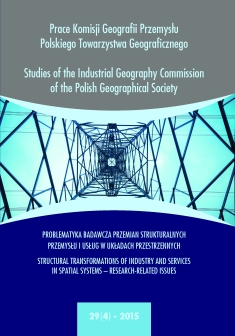Contemporary processes of regional industrial changes in Poland – possible interpretations
DOI:
https://doi.org/10.24917/20801653.294.3Keywords:
mining and manufacturing, Poland, post-socialism, regional development, spatial changeAbstract
Radical institutional, structural and technological changes which took place in Polish manufacturing and mining in the last 25 years are a good reason to discuss changes in spatial organization of this sector. The author aims at identifying the main processes of spatial change of industrial activity in the country at regional scale. This leads to two fundamental questions. First, what are the major factors and mechanisms of the identified spatial industrial change, and second, to what extent industrial changes find expression in regional and local development in various parts of the country. The analysis of trends in the transformation era show that both endogenous and exogenous factors contributed to the industrial growth of metropolitan areas. This was particularly stimulated by skilled labor, market and transport accessibility. The developed regions of Western Poland - Lower Silesia and Greater Poland (Wielkopolska) benefited most of all. A relatively successful restructuring took place in the Upper Silesian Industrial District and to some extent in the Łódż region too. Old industrial regions of the Sudety Mountains and Staropolski were significantly affected by deindustrialization processes at the same time. It is interesting, that the role of manufacturing in non-metropolitan areas has not decreased in general. Industrial development mainly rested on endogenous factors here. The impact of governmental policy on spatial changes in Polish manufacturing and mining took place primarily by means of road investment (new motorways) rather than special economic zones.
Downloads
Metrics
References
Brezdeń, P. (2015). Wybrane aspekty przemian strukturalnych i innowacyjności przemysłu Śląska – ujęcie przestrzenne. Prace Komisji Geografii Przemysłu Polskiego Towarzystwa Geograficznego, 29(2), 123–146.
Chojnicki, Z., Czyż, T. (2006). The role of knowledge in the shaping of knowledge-based economy and economic development of Poland: regional approach. Quaestiones Geographicae, 25B, 7–16.
Domański, B. (2001). Kapitał zagraniczny w przemyśle Polski. Prawidłowości rozmieszczenia, uwarunkowania i skutki. Kraków: Instytut Geografii i Gospodarki Przestrzennej Uniwersytetu Jagiellońskiego.
Domański, B. (2011). Foreign capital and the development of Polish regions. Czasopismo Geograficzne, 82(1–2), 173–187.
Domański, B., Dej, M., Działek, J., Gwosdz, K., Sobala-Gwosdz, A. (2011). Znaczenie przemysłu dla „inteligentnego i trwałego” rozwoju regionu Polski Wschodniej oraz podejmowanych działań dotyczących jego restrukturyzacji i modernizacji. Warszawa: Ekspertyza przygotowana na zlecenie Departamentu Programów Ponadregionalnych Ministerstwa Rozwoju Regionalnego.
Domański, B., Guzik, R., Gwosdz, K., Dej, M. (2013). The crisis and beyond: the dynamics and restructuring of automotive industry in Poland. International Journal of Automotive Technology and Management, 13(2), 151–166.
Domański, B., Gwosdz, K. (red.) (2005). Dziesięć lat doświadczeń pierwszej polskiej specjalnej strefy ekonomicznej. Mielec 1995–2005. Kraków–Mielec: Instytut Geografii i Gospodarki Przestrzennej Uniwersytetu Jagiellońskiego.
Gierańczyk, W. (2014). Economic situation in the manufacturing sector as an example of modern research in industrial geography in Poland. Prace Komisji Geografii Przemysłu Polskiego Towarzystwa Geograficznego, 25, 25–55.
Gierańczyk, W., Rachwał, T. (2012). Structural changes in the industry of Poland against the background of eastern European Union states. Quaestiones Geographicae, 31(2), 83–93.
Gwosdz, K., Micek, G. (2010). Spatial agglomerations in the Polish automotive industry. Przegląd Geograficzny, 82(2), 159–190.
Hayter, R. (2004). Economic geography as dissenting institutionalism: the embeddedness, evolution and differentiation of regions. Geografiska Annaler, Series B: Human Geography, 86(2), 95–115.
Jarczewski, W. (2012). Pozyskiwanie inwestorów do gmin. Warszawa: Wolters Kluwer.
Komornicki, T. (2004). Obszary koncentracji eksportu w przestrzeni przemysłowej Polski. Przegląd Geograficzny, 76(4), 473–491.
Lijewski, T. (2003). Koncentracja ośrodków aktywności gospodarczej w Polsce w świetle list 500 firm.
Przegląd Geograficzny, 75(3), 433–447.
Mrozińska, A. (2013). Zmiany strukturalne w przemyśle przetwórczym według województw w latach 1999–2010. Prace Komisji Geografii Przemysłu Polskiego Towarzystwa Geograficznego, 21, 157–172.
Rachwał, T. (2011). Wpływ kryzysu na zmiany produkcji przemysłowej w Polsce. Prace Komisji Geografii Przemysłu Polskiego Towarzystwa Geograficznego, 17, 99–113.
Rogacki, H. (2006). Large industrial enterprises in Poland: changes in regional pattern. Quaestiones Geographicae, 25B, 53–60.
Roukova, P., Keremidchiev, S., Sobala-Gwosdz, A., Evgeniev, E. (2009). Local production networks and governance: a comparative study of the footwear industry in Bulgaria and Poland. Problems of Geography, 1, 72–88.
Smętkowski, M. (2008). Rola specjalnych stref ekonomicznych w kształtowaniu struktury przestrzennej przemysłu w Polsce. Prace Komisji Geografii Przemysłu Polskiego Towarzystwa Geograficznego, 10, 204–216.
Stachowiak, K., Stryjakiewicz, T. (2008). Institutional approach in economic geography and its relevance to regional studies. Quaestiones Geographicae, 27(1), 7–20.
Stryjakiewicz, T. (1999). Adaptacja przestrzenna przemysłu w Polsce w warunkach transformacji.
Poznań: Wydawnictwo Naukowe UAM.
Stryjakiewicz, T. (2014). Changes in Polish industrial geography at the turn of the 21st century. Prace Komisji Geografii Przemysłu Polskiego Towarzystwa Geograficznego, 25, 7–19.
Szejgiec, B., Komornicki, T. (2015). Spatial differentiation of Polish export linkages. Geographia Polonica, 88(1), 173–178.
Śleszyński, P. (2003). Struktura i rozmieszczenie ośrodków zarządzania w polskiej gospodarce.
Przegląd Geograficzny, 74(2), 199–226.
Śleszyński, P. (2007). Gospodarcze funkcje kontrolne w przestrzeni Polski. Prace Geograficzne Instytutu Geografii i Przestrzennego Zagospodarowania PAN, 213.
Tobolska, A., Matykowski, R. (2006). Działalność przemysłowa w warunkach wzrastającej internacjonalizacji i globalizacji na przykładzie wybranych produktów. Prace Komisji Geografii Przemysłu Polskiego Towarzystwa Geograficznego, 8, 47–59.
Wdowicka, M. (2002). Wykształcanie się nowych obszarów przemysłowych w strefie podmiejskiej Poznania. Prace Komisji Geografii Przemysłu Polskiego Towarzystwa Geograficznego, 3, 115–122.
Wieloński, A. (2000). Geografia przemysłu. Warszawa: Wydawnictwo Naukowe PWN.
Downloads
Published
How to Cite
Issue
Section
License
Articles are published under the terms of the Creative Commons License (CC BY-ND 4.0; Attribution– NoDerivs).

